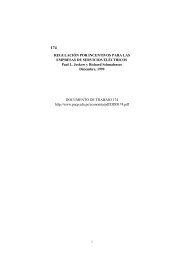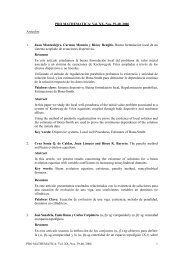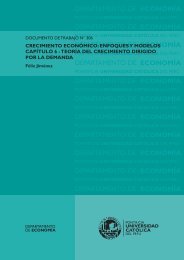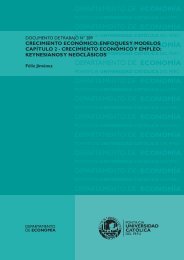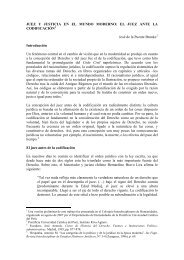Econometría de Evaluación de Impacto - Pontificia universidad ...
Econometría de Evaluación de Impacto - Pontificia universidad ...
Econometría de Evaluación de Impacto - Pontificia universidad ...
You also want an ePaper? Increase the reach of your titles
YUMPU automatically turns print PDFs into web optimized ePapers that Google loves.
Pue<strong>de</strong> notarse que el supuesto acerca <strong>de</strong>l mismo efecto temporal en 0<br />
y<br />
0<br />
0<br />
se cumple al ser paralelas las rectas E ( y | d = 0),<br />
E(<br />
y | d = 0)]<br />
y la recta<br />
56<br />
[ 0 1<br />
1 1<br />
0<br />
0<br />
E ( y | d = 1),<br />
E(<br />
y | d = 1)]<br />
. Si tal paralelismo no se cumple, el estimador <strong>de</strong><br />
[ 0 1<br />
1 1<br />
y<br />
diferencias en diferencias sería un estimador incorrecto <strong>de</strong> <strong>de</strong> ATET.<br />
El gráfico anterior muestra claramente que el estimador <strong>de</strong> diferencias en<br />
diferencias es el ATET y no el ATE. Es <strong>de</strong>cir el cálculo no es válido<br />
externamente para otros grupos distintos a los beneficiarios.<br />
En términos <strong>de</strong> regresiones, se pue<strong>de</strong> obtener el estimador <strong>de</strong> diferencias<br />
en diferencias <strong>de</strong> la regresión<br />
E<br />
E<br />
0<br />
0<br />
( y | d1<br />
0<br />
0<br />
( y | d1<br />
= 1)<br />
=<br />
0)<br />
y = β d + µ + λ + ε<br />
it<br />
Gráfico 5<br />
t = 0 t = 1<br />
d<br />
it<br />
don<strong>de</strong> it y es el valor observado <strong>de</strong>l resultado, µ i muestra un efecto<br />
individual (efecto fijo) no observable que afecta a la variable resultado, λ t<br />
es un componente temporal no observable que genera el “efecto periodo”<br />
y ε it es un término <strong>de</strong> error <strong>de</strong> media cero, varianza condicional<br />
constante y no correlacionado con ninguna <strong>de</strong> las <strong>de</strong>más variables ni con<br />
i<br />
t<br />
E<br />
E<br />
E<br />
it<br />
1<br />
1<br />
( y | d1<br />
0<br />
1<br />
( y | d1<br />
0<br />
1<br />
( y | d1<br />
= 1)<br />
= 1)<br />
=<br />
0)<br />
Tiempo<br />
δT<br />
∆d<br />
∆t




